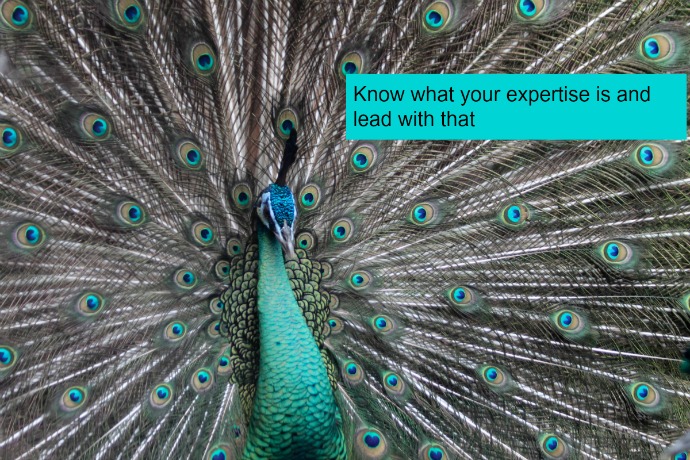Guru. Master. Legend.
Wouldn’t those be nice words to hear after someone introduces you?
Maybe. Personal branding is all the rage these days. But most of us don’t have to be THE leading voice on a certain topic, but a unique, thoughtful and useful voice that is part of the conversation.
I say: Beware the lone guru.
There are so many “personal brands” out there, claiming to be expert in this, or someone who can teach you the secrets of that, or the end-all, be-all source for (INSERT TOPIC HERE).
How nice for them.
The ones who claim to be experts in helping you establish yourself as an expert make me giggle the most. I mean, you should at least have some experience or competency in your chosen field before you expect that article in Fast Company. Experts are not invented, they are cultivated. What are your special skills, talents, experiences that can form a solid, authentic foundation for you to then learn even more and become a valid expert?
My vocation of choice is as a storytelling expert: small business brand strategy, marketing, messaging. Do I know all there is to know about these topics? Hell to the no. I am one of MANY brand strategists and experts. And that’s totally cool with me.
It’s not about offering people one authoritative voice to follow, one cult to join, one Kool-Aid flavor to drink. (Tweet!) There are so many talented brand strategists out there – seeming competitors – whom I admire, follow, learn from and even cite.
No one built up their knowledge and competency on their own. They learned it from somewhere, from someone.
But if you want brand awareness for yourself or your company, if you want to get press + customers + love + speaking gigs + influence, it is a good idea to establish yourself as part of that expert tribe, as someone with a valuable perspective and keen insight into this area. So instead of getting frustrated every time you see one of these vocal, self-promotional, personal brand “experts” instead of pouting, why not follow some simple tips to join the conversation?
Here are 5 tips on how to establish yourself as an expert
(and no, I’m not claiming to be an expert in expertise – these are just tips I’ve used that have opened up new opportunities for me to help brands + businesses). All of these assume you already have a true level of education, knowledge or experience in your chosen area:
Keep soaking up knowledge:
That’s right. Think you know all there is to know about your topic? You’re done before you even start. Read the best-selling authors out there, attend conferences, read blogs and newsletters. Find out how others are approaching this area, stay up-to-date on trends, and pick and choose which bits of wisdom resonate – or don’t (see Tip #2) – with how you view this topic area. Keep a list of 5-10 sources to follow regularly so you don’t get overwhelmed.
Present a point of view:
It’s not enough to go out there and agree with every expert you read or follow in your space. Often, if you can present a valid, contrarian point of view, people find that much more interesting – and the press may bite. I have often used contributed articles (see Tip #3) and blog posts to say why I thought a certain expert got it wrong, and put my own unique spin and experience on the situation. Being willing to challenge the status quo – for real reasons, not just to be a pain in the neck – displays confidence and authority that people will notice. For some great advice about presenting value-drive content that rabid fans will adore, check out this Jay Baer blog post.
Write & pitch contributed articles/stories:
Not every piece of content you write should be about selling your products or services. People don’t pay to subscribe to news feeds or publications to get commercials. But can you convince Entrepreneur.com that you’re the perfect person to comment on 5 ways companies are actually making money from better SEO? Can you convince Katie Couric that 5 overlooked stressors are making women and mothers ill? Can you persuade TechCrunch to accept your premise that Big Data is changing the way companies roll out new products and features? Think about the macro trends and theories rather than just your own offerings and offer a thought leadership point of view that benefits everyone. Sidenote: Offering guest blog posts to robust online communities like Biznik or BizHive or influential blogs is also very effective.
Speak in public:
Nothing impacts your street cred more than presenting to group as the…you guessed it…guest expert! Have you contacted your local Chamber of Commerce, Small Business Administration or chapter of a national association? Pitch yourself as a speaker on your topic of interest (no sales pitches, please – except they may allow you to have one slide at the end to promote your book, service or special offer). Start building your buzz locally first and then you can start to point to those successes when applying to national event and conferences. Nervous about presenting? Hire a speaking coach, media + presentation coach, or other developmental coach to squash those fears and help you get your message out there. Some great resources for creating an online speaking profile and finding gigs are SpeakerMatch and eSpeakers.
Blog:
Cue the groans. But I’m telling you, blogging is one of the single best – and free – ways to share your philosophy and highlight your expertise on an on-going basis. You don’t need permission or acceptance like you do for scoring a media article or on-camera interview. Think of your blog as YOUR media outlet where you can say whatever the heck you like, Wrote a contributed article about the new rules of workplace etiquette and no publications bit? Fine, post it on your blog. See a juicy new trend in your space that you’re dying to comment on? You can post it tomorrow. The other added benefit of blogging regularly is that you become search engine friendly around these topics, and the more content you have online, the better to establish your expertise when people are searching for info on those topics. Want proof of the power? I often receive both media and sales leads from blog posts that I’ve written 3 or 4 years ago. Need help on where to start and what to write about – or even just how to work with your blog? Take a session with this woman now or check out Problogger for fabulous tips.
What actions have worked for you in establishing your expert status? Which experts do you admire and follow? Share your thoughts and get some link love back to your (expert) site!
 There are two common challenges people claim when trying to build an expert, influential brand. Do either of these sound familiar?
There are two common challenges people claim when trying to build an expert, influential brand. Do either of these sound familiar?



